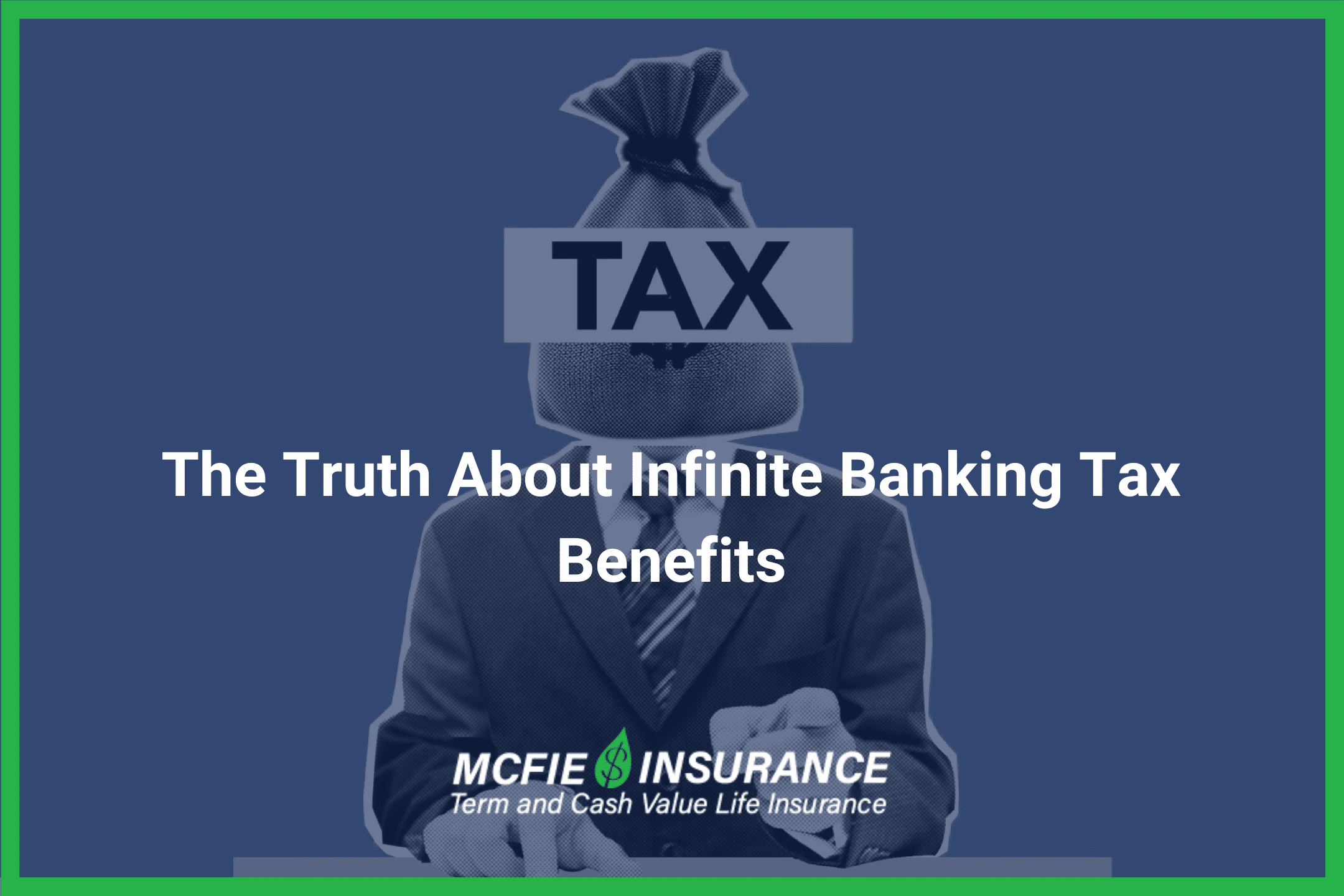317-912-1000
317-912-1000

If you’ve been researching Infinite Banking, you’ve probably heard it described as “tax-free.” That phrase gets thrown around frequently in financial circles, and while it sounds appealing, it’s not entirely accurate. The reality is more nuanced, and understanding these details can make a difference in how you leverage Infinite Banking with participating whole life insurance for long-term wealth building.
Is Infinite Banking tax-free? Not exactly. But when properly structured with participating whole life insurance, it offers tax advantages that few other financial strategies can match.
Tax implications can have a big impact on financial strategies, and one of the biggest myths in the Infinite Banking space is that it’s completely tax-free. While Infinite Banking does provide incredible tax advantages when implemented through participating whole life insurance, there are rules you have to follow to maintain those benefits. Failing to do so could create unnecessary tax liabilities—something we help our clients avoid through proper policy design and ongoing guidance.
We specialize in participating whole life insurance because it’s the stalwart of the insurance industry, and for good reason. Unlike non-participating policies, participating whole life insurance offers dividends to policyholders, allowing you to share in the profits of the insurance company.
What makes participating whole life special:
As Nelson Nash wrote in Becoming Your Own Banker, participating whole life insurance policies are “engineered to become more efficient every year, no matter what happens.”

First, let’s clear up a misunderstanding: Infinite Banking is not a financial product with its own tax status. It’s a process for controlling your cash flow using a properly designed participating whole life insurance policy from a mutual company.
The tax advantages come from the underlying tool—your participating whole life policy—not from some mystical “tax-free” account. This distinction matters because it helps you understand that the strategy’s power comes from how you use the policy, not just from the policy itself.
When properly structured, participating whole life insurance provides three major tax benefits:
Your cash value accumulates without immediate taxation, meaning you’re not taxed on the growth each year. Unlike taxable investment accounts where you pay taxes annually on gains, dividends, and interest, your policy’s guaranteed growth plus dividends compound without current tax consequences.
This growth includes the guaranteed returns built into your contract and the dividends you receive from the mutual company’s performance. Over time, this compounds into value that would have been reduced by annual taxation in other financial vehicles.
When you borrow against your policy, it’s not considered taxable income because it’s a loan, not a withdrawal. This is where much of the “tax-free” perception originates—you can access your money without triggering a tax event.
Here’s what makes this powerful with participating whole life insurance: when you take a policy loan, your cash value continues earning the same guaranteed returns plus dividends as if you hadn’t borrowed against it. The insurance company’s money funds your opportunity while your money continues growing in your policy.
The death benefit is paid to your beneficiaries without income tax, providing tax-free legacy transfer. With participating whole life, this death benefit grows over time due to dividend additions, creating even more tax-free value for your heirs.
These tax benefits work together to create a compounding effect that becomes more powerful over time. If you’re in a 30% tax bracket and earn 5% in a taxable account, your after-tax return is only 3.5%. But with participating whole life insurance, you keep the full guaranteed return plus dividends, allowing for more capital to compound over your lifetime.
Early Years
During the initial years of your participating whole life policy, you’re building what’s called “paid-up insurance”, the portion of your death benefit that you own. This paid-up insurance represents real equity in your policy, similar to equity in real estate.
The cash value of your policy is the value of this paid-up insurance, and it can be accessed through withdrawals or used as collateral for loans. However, withdrawals permanently reduce your death benefit and future growth potential, which is why policy loans are preferred for accessing funds.
The Break-Even Point and Beyond
Here’s where participating whole life insurance is truly powerful: with as little as $6,000 annually, a participating whole life policy built for infinite banking will frequently have more guaranteed cash value available than what you’ve paid for premiums within the first 9-12 years.
But annual guaranteed cash value increases typically exceed the annual premiums payment as early as year 5. It is not uncommon to see policies which have been built for infinite banking producing guaranteed cash value growth exceeding 150% of the annual premium payment in later policy years. These cash value increases are contractually guaranteed, not market-dependent projections.
This efficiency, combined with the tax advantages, creates a powerful wealth-building tool that provides security and opportunity.
The “Tax-Free” Oversimplification
While policy loans are indeed tax-free, this doesn’t mean participating whole life insurance operates in a tax-free vacuum. There are rules and limitations that have to be respected to maintain these advantages.
The MEC Trap
The Modified Endowment Contract (MEC) rule exists to prevent people from using life insurance as a tax shelter. If your policy violates MEC guidelines by accepting too much premium too quickly, any loans or withdrawals above your cost basis become taxable as ordinary income.
This is why working with specialists in participating whole life design is crucial. We ensure your policy structure maximizes funding while staying safely within MEC limits, preserving tax advantages.
Policy Lapse Consequences
If a participating whole life policy with outstanding loans lapses or is surrendered, any cash value above your cost basis becomes taxable income. This is another reason why ongoing guidance from experienced professionals matters.
How Dividends Work
Participating whole life insurance dividends represent your share of the mutual company’s surplus—the excess of income over expenses and required reserves. These dividends aren’t guaranteed, but many mutual companies have paid them consistently for over 100 years.
When dividends are paid to purchase additional paid-up insurance (the most common option), they increase both your cash value and death benefit. This creates a compounding effect where your dividends earn future dividends—growth upon growth.
The Tax Treatment of Dividends
Dividends received on participating whole life insurance are generally not taxable income. They’re considered a return of premium until they exceed what you’ve paid into the policy. This means the dividend growth compounds without current taxation.
Why Non-Participating Falls Short
Non-participating policies don’t offer dividends, which means you miss out on sharing in the company’s profits and the additional tax-advantaged growth that dividends provide. For Infinite Banking purposes, participating policies from mutual companies are far superior.
Mutual life insurance companies have a different business model than stock companies, and this difference directly impacts your policy’s performance and tax advantages:
Ownership Structure
Financial Strength and Stability
This approach creates stability. Mutual life insurance companies invest mainly in investment-grade corporate bonds, commercial real estate, and mortgages—asset classes that provide steady, predictable returns rather than volatile market gains.
The track record speaks for itself: many mutual companies have paid dividends for over 100 consecutive years, demonstrating their ability to generate consistent surplus year after year, regardless of economic conditions.
Understanding fees is crucial when comparing financial products, and participating whole life insurance has an advantage over other options:
Whole Life vs. Universal Life Fees
While universal life policies charge percentage-based fees (often 6% of your premium), participating whole life uses a flat, fixed fee structure. For example:
This fee structure means that participating whole life insurance becomes more efficient as your premium increases, while universal life fees grow proportionally with your contributions.
The Long-Term Impact
Fees can devastate long-term wealth building. A 2.5% annual fee can eliminate 80% of your lifetime contributions and growth. The flat fee structure of participating whole life insurance helps preserve more of your money for actual wealth building rather than fee payments.
Don’t Let Taxes Drive Every Decision
One of the biggest mistakes in financial planning is allowing tax considerations to override sound financial strategy. We’ve seen investors hold losing stocks to avoid capital gains taxes, only to lose far more than they would have paid in taxes. The same principle applies to Infinite Banking—don’t structure your strategy solely around tax benefits.
Focus on the Complete Picture
Tax savings should complement, not dictate, your wealth-building strategy. The real value of participating whole life insurance lies in:
Quality Policy Design Matters
Not all participating whole life policies are created equal. The design of your policy, how much premium goes toward paid-up insurance versus insurance costs, the timing of premium payments, and the specific riders included, impacts tax efficiency and overall performance.
A poorly designed policy might barely meet MEC requirements while providing minimal early cash value growth. A well-designed policy maximizes early cash value development while staying comfortably within MEC limits, creating both tax efficiency and practical utility.
Proper Policy Structure
To maximize tax advantages and policy efficiency:
Smart Loan Management
Policy loan strategy affects both taxes and long-term policy performance:
Distribution Planning
For retirement income or major financial goals, proper distribution planning ensures tax efficiency:
To maximize the benefits of Infinite Banking with participating whole life insurance:
Is Infinite Banking with participating whole life insurance tax-free? Not entirely, but it offers some of the most powerful tax advantages available in the financial world when properly implemented.
More importantly, participating whole life insurance provides something more valuable than tax benefits: guaranteed, predictable wealth building with unmatched liquidity and control. It’s a strategy that has worked for savvy individuals, business owners, and corporations for over a century, and it will continue to work regardless of what happens in the markets or tax code.
When you combine the tax advantages with the guaranteed growth, dividend participation, and unparalleled liquidity of participating whole life insurance, you create a financial foundation that can support wealth building for generations.
The key is working with specialists who understand the strategy and the specific advantages of participating whole life insurance from mutual companies. That’s where our expertise makes the difference between a good policy and a great one.
 Tomas P. McFie DC PhD
Tomas P. McFie DC PhD
Tom McFie is the founder of McFie Insurance and co-host of the WealthTalks podcast which helps people keep more of the money they make, so they can have financial peace of mind. He has reviewed 1000s of whole life insurance policies and has practiced the Infinite Banking Concept for nearly 20 years, making him one of the foremost experts on achieving financial peace of mind. His latest book, A Biblical Guide to Personal Finance, can be purchased here.